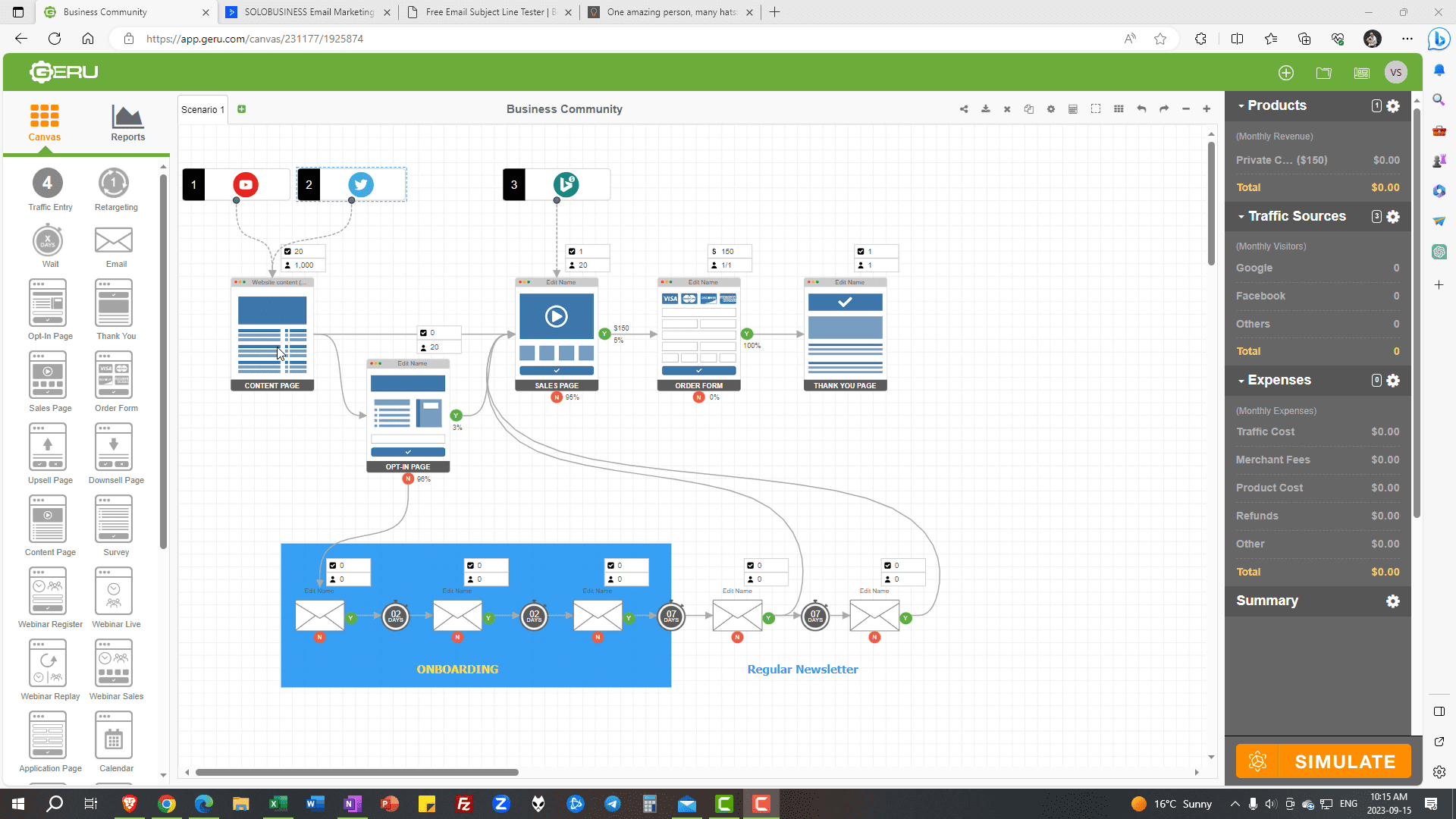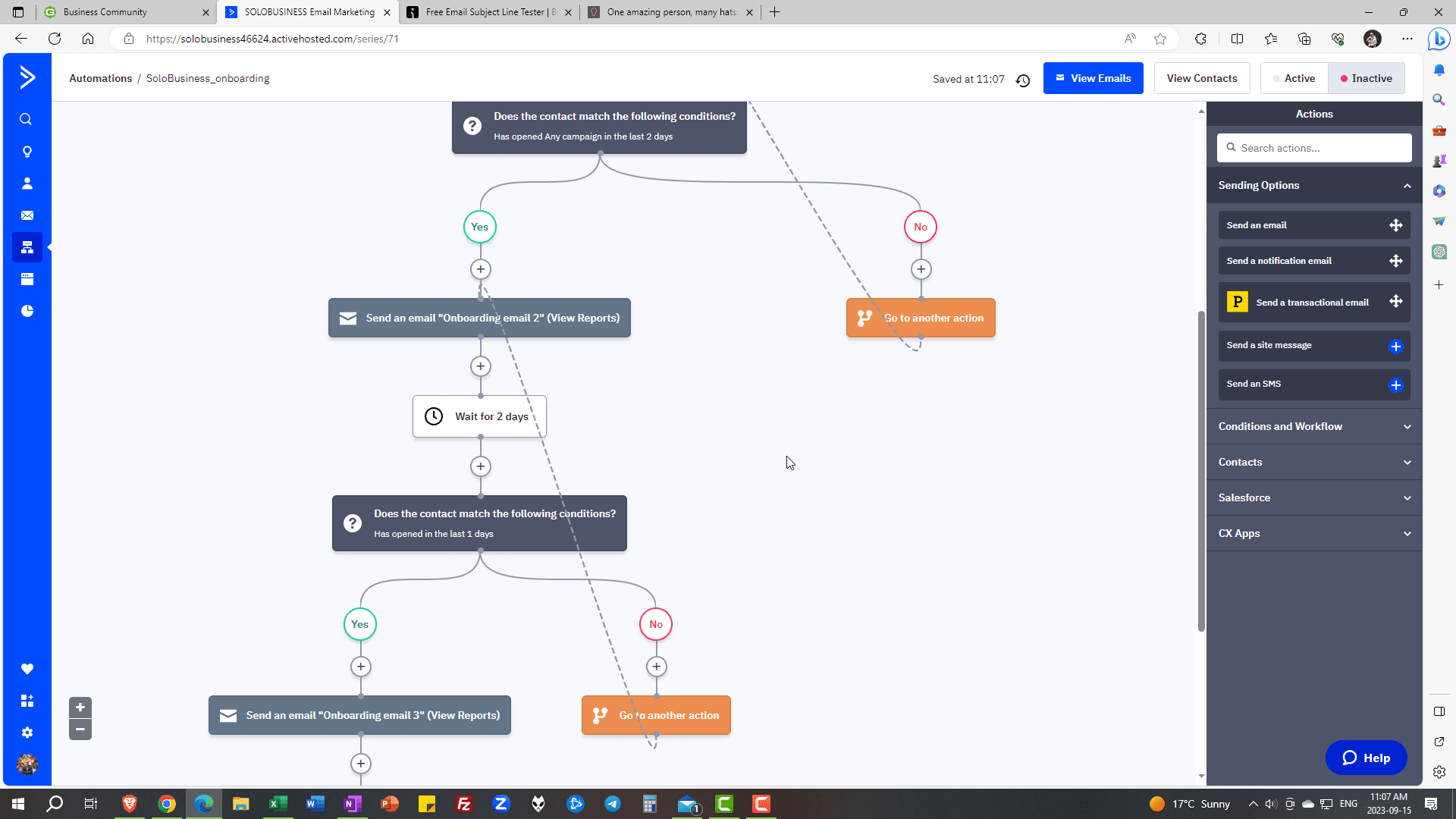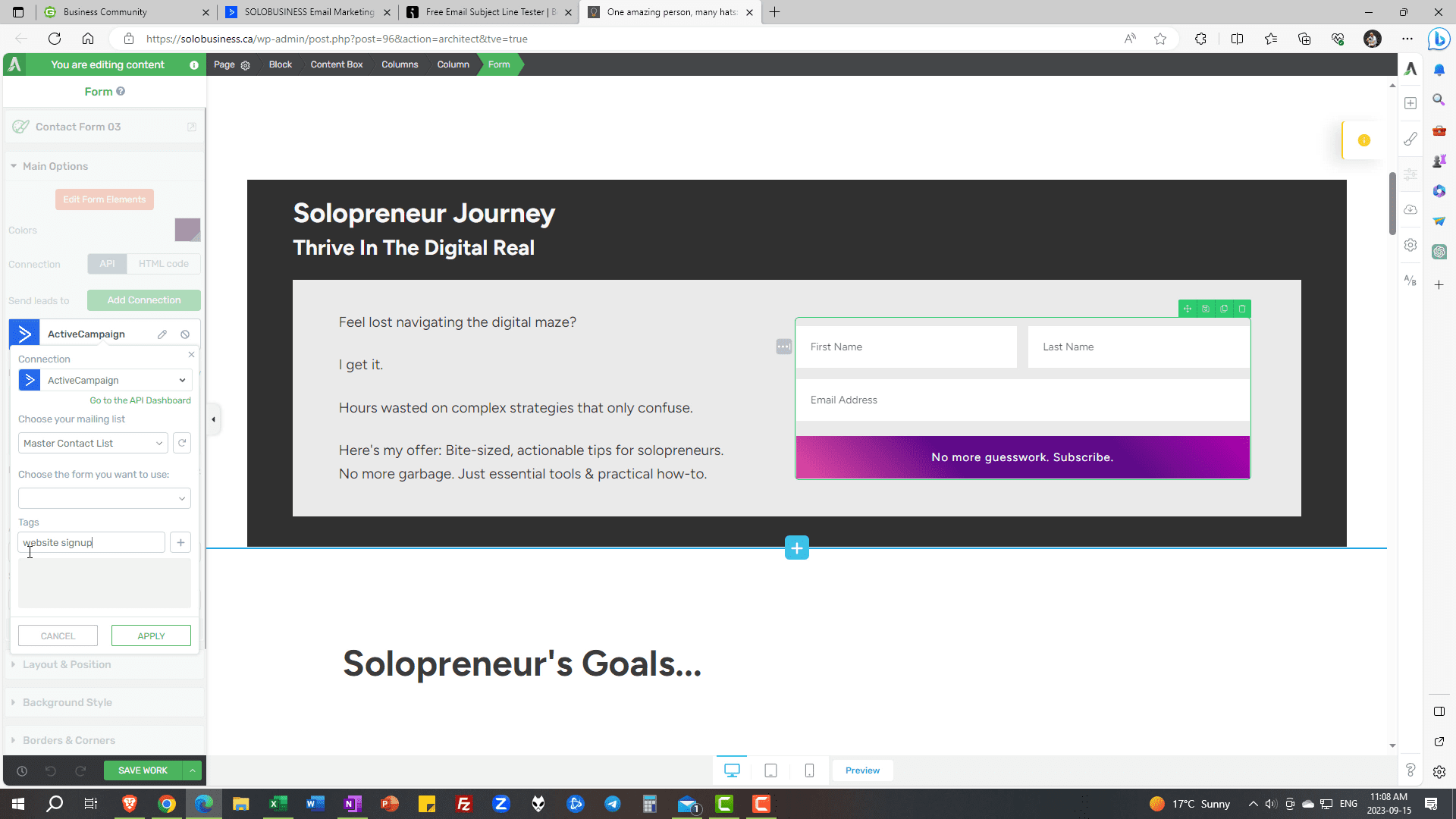Introduction: The Importance of Email Sequence / Lists
Email sequence is the power-up to email lists and is the lifeblood of any successful online business. I cannot emphasize this enough. Seriously, if you skip over this part or think "I'll do this later", you are shooting yourself in the foot. Email sequence is that critical... Unless of course you are big on wasting time. But, of course, you're not!
Think of an email list like a garden. You need to nurture it, water it, and care for it consistently. (< email sequence is the autopilot way of doing it)
Over time, with patience and persistence, it will blossom into something beautiful and fruitful. But neglect that garden even for a short time and it will wither away.
I see so many solopreneurs make this mistake. They focus entirely on driving traffic and getting new signups, but don't take the time to create an automated welcome sequence, send regular broadcasts, or build relationships.
Don't let this be you!
Now I know, technology and email marketing can feel overwhelming. But stick with me on this journey and I'll walk you through it step-by-step.
I also recommend you do a refresher on what the original "plan" was for my online offering and where it fits with the email marketing part.
In this article, we'll dive into crafting a winning and simple 3x email sequence that welcomes nurtures new subscribers using AI tools like ChatGPT and Claude AI. I'll even give you my proven email prompts for generating amazing content in seconds!
Ready to get growing? Let's do this! (and if you're lazy - the top level points are in this video).
Crafting a Winning Email Sequence: Welcome Campaign
Imagine someone signs up for your email list, how you welcome them sets the tone for your entire relationship.
You want to wow them right out of the gate!
Think back to the last time you stayed at a nice hotel. When you first walked in, didn’t you just feel special? From the warm greeting at check-in to the chocolate on your pillow, it was welcoming from start to finish.
That's exactly what you want to create for new email subscribers! And your email sequence should do it automatically. This the the key to your sanity and effective email marketing.
The key is setting clear expectations upfront. Remove any uncertainty about what this person signed up for and what you’ll be sending them.
For example, instead of just sending a quick “Thanks for subscribing!” email, tell them exactly what to expect from your list, how often you’ll be emailing, the types of valuable content you’ll provide, and how to get help if needed.
Paint a crystal-clear picture so they know what’s coming and get excited for your emails!

Setting Clear Expectations
Ready to craft your welcome email sequence? Let's start with that important first email. This is where you need to set easy-to-understand expectations right up front.
While various types of businesses will require nuanced frameworks (read to the end to find out). I recommend at the very least this simple 3-part structure for your generic email sequence:
- Warm welcome and introduction
- Overview of what they'll get from your list and “do-this” CTA
- Next steps for getting started, actionable value-added links
Resist the temptation to overloaded them with content right away. Remember, this is the "meet and greet" email, not a data dump!
Keep it short, personal and focused on getting them excited about what's to come.
For example, highlight the key benefit of your email list - is it amazing content, special deals, a supportive community? Let them know the frequency and types of emails to expect.
And give a clear CTA for getting started like checking their inbox tomorrow for email #2.
When your new subscriber knows exactly what’s coming, they'll look forward to each email!
The Three-Component Welcome Sequence (additional details)
Once you've set expectations in email #1, it's time to deliver an amazing 3-part welcome sequence.
Each email serves a specific purpose:
Recall, Email #1: The Introduction
- Welcome & set expectations
Email #2: Ask About Their Interests, Pain Points
- Get to know them better without being too intrusive (t’s just the beginning of your relationship)
Email #3: Set Expectations
- Explain what comes next.
- Why it is important to THEM.
- What should they be looking forward to?
I recommend sending email #2 one day after the intro email, and email #3 two days after that.
Spacing things out gives time to build anticipation and keeps you top of mind without being overbearing.
In email #2, include a short survey or quiz to learn about your new subscriber. Discover their biggest challenges, interests, goals - anything helpful for you to provide personalized value!
Then in email #3, share what they can expect from your regular email broadcasts, like the frequency, types of content, special offers, etc.
This seals the deal on an awesome welcome experience!
Key Metrics for Success
Once your 3-part welcome sequence is ready to launch, let's discuss some key metrics to track its effectiveness:
- Open rate - This shows what % of recipients actually open your email. For welcome sequences, aim for at least 20%.
- Click-through rate - The % who click on any links/CTAs within your email. Good welcome emails will have 2-4%+ CTR.
- Unsubscribe rate - The % who opt-out from your list. For welcome emails, this should be less than 1%. A high unsub rate means your expectations aren't clear.
It's also important to track client responses to your emails. If you included a request for feedback in email #1, monitor responses to improve future welcome sequences.
Pay attention to any spam complaints too, as that impacts your sender reputation. Lastly, track link clicks to see what content resonates most.
Optimizing based on these metrics results in higher open and click rates over time!
Maximizing Email Delivery and Engagement
You crafted an amazing 3-part welcome sequence. Now let's ensure as many people as possible actually see your emails.
A common mistake is sending an email once and never following up with non-openers. Just because someone doesn't open email #1 doesn't mean they aren't interested. They likely just missed it in their inbox!
That's why I recommend resending any welcome sequence emails that go unopened. Give each email a "second chance" before moving on.
For example, if someone doesn't open email #1, send it to them again in 2-3 days. Same goes for email #2. You spent time crafting this great content - make sure subscribers see it!
Following up with non-openers can improve open rates by 15% or more. Yes, it involves a bit more work, but it's worth it. Just make sure your email subject lines are updated to indicate it's a reminder.
Now let's discuss how to automate this...
Implementing the Strategy with ActiveCampaign CRM
To automate your welcome email sequence and follow-ups, you'll need an email marketing platform like ActiveCampaign.
Here are the key steps to implement it:
- Create your master contact list in ActiveCampaign to collect all new subscribers.
- Set up tags and custom fields to segment your list, like "Welcome Series".
- Build your 3-part email automation with delays in between each message.
- Trigger the sequence when a new contact joins your list.
- Use segmentation to identify non-openers and re-send emails to them.
- Make sure to personalize all emails using merge tags like %FIRSTNAME%.
The time spent setting this up provides endless dividends through automated lead nurturing. Just don't forget to monitor and tweak based on open/click rates!
Choosing the right email platform is critical. I recommend ActiveCampaign for its automation and segmentation capabilities.
Personalization and Subject Line Testing
Now that your automation sequence is set up in ActiveCampaign, let's focus on crafting the messages.
Personalization is key - every subscriber wants to feel you're speaking directly to them.
Make sure to use first name merge tags in your email subject line and body. This small touch makes a big impact!
Speaking of subject lines, these make or break whether your email gets opened. Subject line testing is a must.
Tools like Omnisend allow you to test different subject lines to see which drives the highest open rates.
Testing out multiple variants helps you learn what works.
Little optimizations like these improve open and clickthrough rates dramatically over time!
Now let's tackle creating killer email content...
Content Creation and Automation with ChatGPT / Claude AI
Creating compelling email sequence or email content week after week can be daunting and outright nerve-wrecking, I know. But AI tools have been an absolute game-changer!
Let me introduce you to a set of my new secret weapons – ChatGPT and Claude AI. These AI tools allows you to generate high-quality email content in seconds.
I am being prescriptive here. It is using both of them not either-or. The thing is on free plans, ChatGPT is still the king when it comes to structure, but Claude is much more elegant in actual content creation.
Simply describe what you want your email to cover, provide any key details, and ChatGPT will return polished copy ready for you to customize.
I gave my AI assistants (ChatGPT and Claude AI) the email content parameters and it auto-generated the copy. A quick edit for personalization and I was all set!
Take advantage of AI to rapidly create compelling content at scale. More time for living life, less time writing emails!
Now let's talk formatting best practices...
Formatting for High Deliverability
When formatting your emails, simplicity and clarity are key for high deliverability.
Avoid using complex tables, embedded images, or fancy formatting in your welcome sequence. These increase the risk of emails being flagged as spam.
Instead, use a clean, minimal design with good spacing between paragraphs. This optimizes readability on mobile devices as well.
One important tactic is to track all links back to your website. URL shorteners like Bitly often trigger spam filters.
So use your own domain to redirect links. This builds reputation with email providers to safely land in the inbox.
Lastly, test your final welcome emails on multiple devices and email clients. Check that images, spacing, and links all render properly before sending.
A bit of upfront care in formatting goes a long way in email deliverability and open rates!
Alright, we're in the home stretch. Let's activate this thing!
Fine-Tuning and Activation of your email sequence
We've covered a ton of ground so far. Let's do a final pass to optimize our welcome email sequence before activating it.
First, review the email automation you built in ActiveCampaign. Make any last tweaks to the timing or conditional logic.
For example, confirm your re-sends to non-openers are properly configured.
Next, grab those amazing ChatGPT or Claude AI generated emails and paste the content into your sequence. Personalize the copy and double check those subject lines.
Triple check all your links, formatting, spam filter triggers (no spammy words!) and images. Better to catch any issues now.
Once finalized, there's just one thing left - pressing "Activate" and sending your first test emails. It's go time!
Seeing your automation trigger and nurture contacts automatically is so satisfying. You got this!
Integration with Website and Final Tips
Your email welcome sequence is live! Now let's drive traffic and optimize conversions.
I assume you have Thrive Themes powering your WordPress site, I strongly recommend Thrive Leads and other of the embedded products to cut down on integration time and reap the max benefit from conversion focused theme builder..
Thrive Themes makes it super simple to connect your opt-in forms directly to ActiveCampaign. New subscribers are automatically added to your lists and sequences.
Just be sure your call-to-action copy is compelling. For example "Join our community for free business tips!" Let them know the value upfront.
Lastly, remember the power of personalization. Ask new subscribers to reply to your first email and engage in a real conversation.
Nothing builds loyalty better than human-to-human connection. Use that to your advantage!
Conclusion
Well, my friend, you've made it to the end of our journey. I hope you feel empowered to grow your own email lists and create amazing welcome sequences.
Also, do not forget - if you're building a business dependent on appointments, read this to set yourself up and tell your clients about ways of getting a hold of your time in your second email (and every email thereafter).
If you found this helpful, be sure to let me know! I'd love to hear your success stories.
Until next time, here's to your business growth and happiness. Cheers!

P.S.
While welcome sequences lay the foundation, don’t stop nurturing leads once they’re on your list! Here are some other effective lead nurturing approaches:
- Send regular educational newsletters with tips and insights related to their interests
- Promote new blog posts and other content upgrades they’d find valuable
- Use shorter “promo” emails in between full newsletters to share deals and offers
- Consider launching a private Facebook group for your subscribers to connect
- Send event invites, exclusive webinars, or one-on-one consultation offers
- Conduct surveys and quick polls to gather helpful feedback
- Segment your list based on their needs and customize content accordingly
- Reward loyal subscribers with special perks, giveaways and incentives
- Ask for product reviews and testimonials you can share publicly
- Don’t forget real human touch! Reply personally to their emails when possible
The key is providing ongoing value, not just sales pitches. Nurtured leads convert at nearly 50% higher rates. Now get out there and start connecting!
In addition to welcome sequences, here are some other types of effective email sequences:
- Onboarding email sequence - For new customers, spread across 5-7 emails to guide them in getting set up and using your product/service successfully. Cover things like tutorial videos, downloadable resources, onboarding calls, etc.
- Educational or "drip" sequence - Deliver a series of 5-10 emails with helpful tips, tactics, or lessons related to a specific topic area. Release these over weeks or months.
- Event promotion sequence - Create a series of teasers and reminders leading up to a product launch, webinar, or other event.
- Re-engagement sequence - Win back customers who haven't purchased in a while with a short 2-3 email sequence offering promos and new features.
- Seasonal sequence - Celebrate holidays, awareness months, or other seasonal events with themed series of 2-5 emails.
When it comes to welcome sequences specifically, best practice is to keep these short and focused. Typically you want a 3-5 email welcome sequence as follows:
- Email #1: Overview and value proposition
- Email #2: Personalization and getting to know them
- Email #3: Interacting and asking for feedback
- Email #4: Final prep and transition to your regular broadcasts
- Email #5 (optional): Last chance for engagement + promo
Keep your early emails focused on value, education, and relationship-building. Then evolve into promotions and conversions once they're warmed up. Follow this framework for email success!


